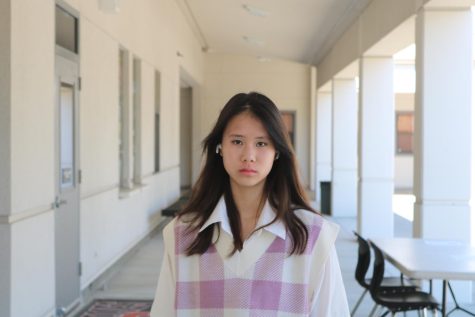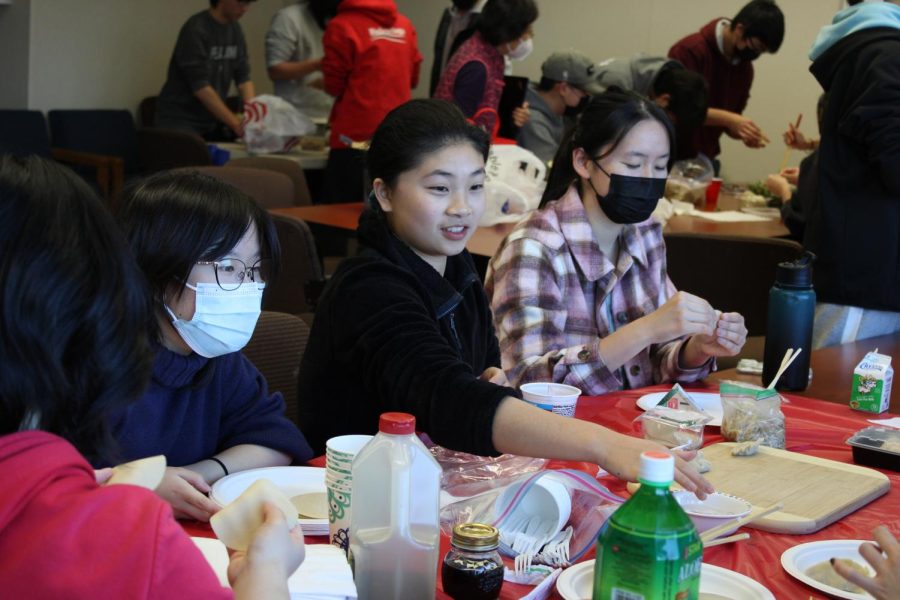Cal wraps up Lunar New Year with dumplings
Chinese students celebrate culture with food and fun
AP Chinese students celebrate Lunar New Year by making dumplings in the teacher’s lounge.
Mandarin teacher Winnie Wang’s AP Chinese students weren’t studying Mandarin syntax and culture as usual on Jan. 20. They were wrapping hundreds of fragrant pork dumplings.
Wang’s Mandarin classes, along with east Asians across San Ramon and throughout much of the Bay Area, were celebrating the arrival of the Lunar New Year of the Rabbit.
The arrival of the annual holiday came on Jan. 22 this year, and Wang took charge when it came to how she wanted each one of her Mandarin classes to celebrate the new year.
“In Chinese 3 and AP, I let my students make Chinese dumplings in class,” Wang said. “This was because, in Chinese culture, the shape of the dumplings are shaped similar to [gold] nuggets, which symbolizes the bringing of fortune to your house.”
Freshman Lucas Chi also noted that Chinese culture is tied very closely to symbolic and spiritual ideas, which is reflected in Lunar New Year celebrations that include different dishes and forms of fortune such as red envelopes.
“Red envelopes are a symbol of connection with elders in accordance with traditional beliefs that have been passed down,” Chi said. “The money that these red envelopes contain is symbolic of bringing good fortune, and also fuels my yearly allowance.”
When kids receive red envelopes from their elders, they often respond to the giver with symbolic expressions to show their appreciation and wish them good fortune.
“When receiving red envelopes, sometimes parents will have you say a thankful greeting to go along with it,” said junior Luke Ko, who takes Chinese 3. “The following are common ones: 恭喜發財, 萬事如意, 身體健康, which translates to ‘bless wealth, general prosperity, and health’.”
Lunar New Year celebrations heavily emphasize auspicious colors such as red and gold.
“Red is seen as a lucky color, which is why we use it to celebrate the New Year,” Wang said. “We use red paper and write lucky words on them to scare away evil spirits. I have my students share these papers with their teachers.”
Wang’s students used calligraphy, a traditional Mandarin writing technique, to write the words. The red calligraphy papers can be seen posted outside of classrooms all across Cal High.
Another key aspect of the Lunar New Year is the assortment of dishes and food that are served.
“The most important part of the Lunar New Year for me is the food,” junior Brian Wang said. “Chinese people will traditionally eat with their families on Lunar New Year’s Eve, serving specific dishes that hold significant meaning.”
For example, fish is a common food that is served during this time. Eating fish is believed to promote abundance in the upcoming year.
“We usually eat fish, since there is a saying often tied to it,” Ko said. “That saying being 年年有餘, which, when separated, means ‘every year and to have a surplus’.”
Though the traditional roots of the Lunar New Year run deep, the most important aspect of the holiday is the time that is spent with the people who matter.
“Most often I will spend each year with my family, since most of my family is abroad we can’t have large gatherings,” senior Edison Zhu who takes Chinese four honors said. “We also take the time to give offerings and prayers to our ancestors.”
The City Center also held a celebration of the Lunar New Year. The event was held on Jan. 22 and included Chinese, Korean, and Vietnamese dance performances, in addition to the famous New Year’s lion dancers. Not to be mistaken with Chinese dragon dancers, this performance is by two people imitating that of a lion, with one controlling the head and the other the rest of the body.
Guests also enjoyed kung fu demonstrations, instrumental performances, and a selfie station. Visitors were also encouraged to wear red to bring luck and honor the traditional roots the color has.

Senior Zaki Humayun is returning for his second year as a writer for The Californian. When he's not busy writing the best stories known to mankind, he's...

Senior Christine Wang has no idea what her role is, but is happy to be a part of the Californian. She often struggles to do most of her work because she...





